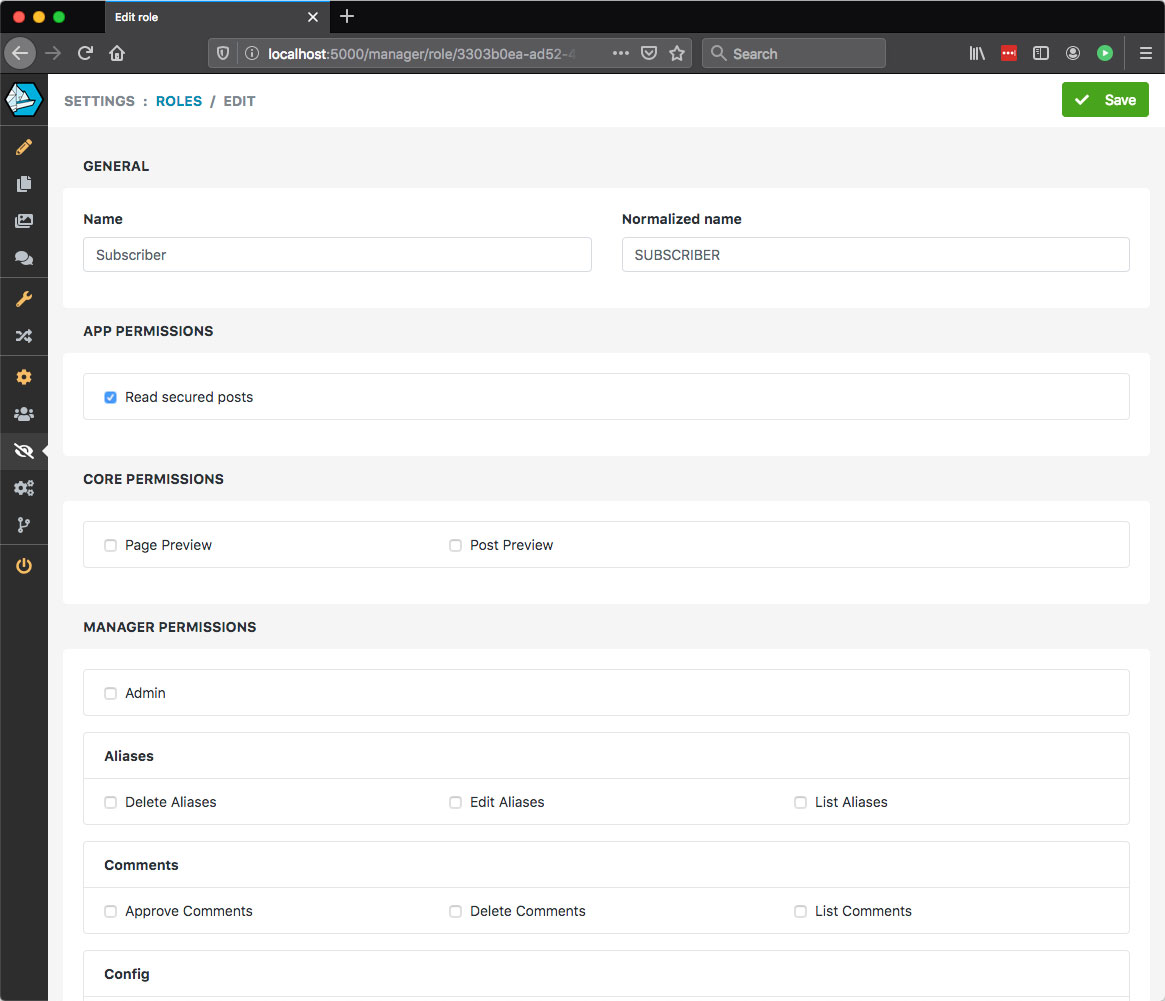Securing Pages
In this tutorial we'll take a look at the recommended way to secure pages in your web application. When we talk about securing pages we mean pages or posts in your public web application that the user needs to be authenticated to view.
Example Code
For this example we've started a new project from the Blog Template for Razor Pages which can be done by executing the following in your terminal:
> dotnet new piranha.razor
Adding Permissions
First off we need to add some permissions. or claims to our application that we are going to use in our front application. For this example we're going to add a new claim called ReadSecuredPosts and add that to a new role called Subscriber. Application claims are added in your Startup.cs.
public void ConfigureServices(IServiceCollection services)
{
...
// Add custom policies
services.AddAuthorization(o =>
{
// Read secured posts
o.AddPolicy("ReadSecuredPosts", policy =>
{
policy.RequireClaim("ReadSecuredPosts", "ReadSecuredPosts");
});
});
}
public void Configure(IApplicationBuilder app, IWebHostEnvironment env, IApi api)
{
...
// Custom permissions
App.Permissions["App"].Add(new Piranha.Security.PermissionItem
{
Title = "Read secured posts",
Name = "ReadSecuredPosts"
});
}
Creating The Role
Once this is done, let's restart the application and log into the manager and create our new Role Subscriber. This role should only have our new claim and look like this once created:

Secondly, let's open up the Blog Archive and the first available post "Welcome to Piranha CMS". After we've opened the post, let's open it's settings add select our new claim as a requirement to be able to view the post.

After this is done, you can see that when we try to access the post through our web browser we get a 401 because we're not authorized to view it.
Adding Login Redirect
The simplest way of handling the fact that we will have two different login pages is to let the manager area use the AuthorizeAttribute and standard redirects of the cookie options. Loading a secured model with the IModelLoader will result in an UnathorizedException which will in turn result in a 401 being returned by ASP.NET.
Knowing this, let's add a middleware component first that listens to the result that comes back, if it is a 401 it means it's an unhandled unauthorized requests from one of our pages.
public void Configure(IApplicationBuilder app, IWebHostEnvironment env, IApi api)
{
...
// Custom middleware that checks for status 401
app.Use(async (ctx, next) =>
{
await next();
if (ctx.Response.StatusCode == 401)
{
ctx.Response.Redirect("/login");
}
});
// Standard Piranha middleware
app.UsePiranha(options => {
options.UseManager();
options.UseTinyMCE();
options.UseIdentity();
});
}
Creating The Login Page
Now the login of your application can be handled any way you'd like, but in this example we're just going to add a simple page with a form post.
Login.cshtml
@page
@model LoginPageModel
@{
ViewBag.Title = "Login";
}
<div class="container">
<article>
<header>
<h1>Login</h1>
<p>The content you requested is unfortunatly for authenticated eyes only. Please provide by logging in.</p>
</header>
<div class="row">
<div class="col-sm-4">
<form method="post">
<div class="form-group">
<label>Username</label>
<input type="text" name="Username" class="form-control">
</div>
<div class="form-group">
<label>Password</label>
<input type="password" name="Password" class="form-control">
</div>
<button class="btn btn-success">Login</button>
</form>
</div>
</div>
</article>
</div>
Login.cshtml.cs
using System.Threading.Tasks;
using Microsoft.AspNetCore.Mvc;
using Piranha;
namespace AuthTest.Pages
{
public class LoginPageModel : Microsoft.AspNetCore.Mvc.RazorPages.PageModel
{
private readonly ISecurity _security;
[BindProperty]
public string Username { get; set; }
[BindProperty]
public string Password { get; set; }
public LoginPageModel(ISecurity security) : base()
{
_security = security;
}
public async Task<IActionResult> OnPostAsync()
{
if (ModelState.IsValid && await _security.SignIn(HttpContext, Username, Password))
return new RedirectResult("/");
return Page();
}
}
}
Wrapping it up
And that's about it. Everything in this example is of course as simple as possible to get the point across, but you can elaborate on this any way you like.